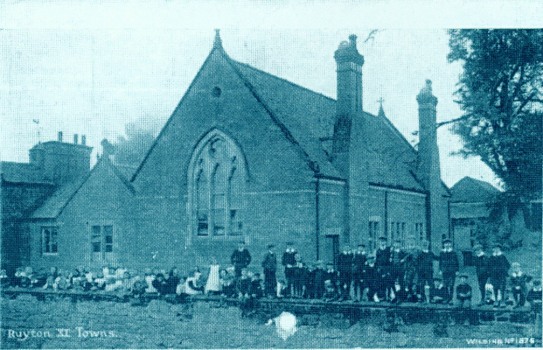
 |
The
ground for the garden, playground and erection of the School was the
gift of
Miss Margaret Kinaston and Miss Anne Kinaston of Ruyton Hall, then
living in
Shrewsbury, Daughters and co-heiresses of Edward Kinaston Esq.
On
January 16th 1818 a Trust was formed to build
and run a School in
the village. Land
known as `Mill Green
Scarow` owned by Miss Margaret and Miss Anne Kinaston
was sold for 10/- ??.
For the sole purpose of being used as a
School for the Education and instruction of young persons of both sexes
to be
always united to the National Society for the promoting the education
of the
poor in the principles of the established Church of England.
Trustees
appointed to oversee the development being:-
Hon
Thomas Kenyon of Pradoe, Rowland Hunt of Boreatton, Rev.
David Evans,
Vicar of Ruyton. The Foundation Deed of Ruyton XI Towns
School was then
set up.
A
total
of £274 15shillings was raised from subscriptions
In
1820
the Annual subscriptions were
£ 56 14
shillings
Between
June 4th 1819 and 1821 the School and Teacher`s house was built
Over
the
years other legacies were left to the trust, the interest from them,
invested
at 4% was to be used by the School alone.
These were Miss Susanna Hunt who left £100,- Mrs Phyllis
Lane £100- The
Misses Kinastons £ 300 Miss Maria Myddleton £30- The House of Industry
Oswestry
(The Workhouse) £200.
These
accounts were kept in a leather bound book
with the following inscription:-
Treasurers
Accounts of the Ruyton XI Tows Charity School, Dr.Bell System
Other
prominent members of local society were also involved in the running of
the
School, these being Charles Spencer Lloyd of Leaton Knolls Thomas
Mainwaring of
Otley, The Hon.
Bulkley Owen of Tedsmore
and John Henshaw Nickson Walford of Ruyton Towers.
In 1871 by Act of Parliament, £90 was given to the School for educating children in accordance with the foundation deed of 1818.
The
Trustees then being appointed were named as
John Kenyon of Pradoe, Charles Spencer Lloyd Q.C of Leaton
Knolls, Rev. Thomas
Mainwaring Bulkley Owen of Tedsmore and Rev. Frances Paget Wilkinson,
Vicar of
Ruyton XI Towns.
At the meeting of the
Trustees in 1871 Mr
Walford of Ruyton Towers offered to sell further land to the School,
being a
cottage and land then adjoining, for £90. School fees were to be 1d per
week
per pupil which in 1870 amounted to £35, rising to £40 by the 1900’s. In addition, there were
the local
subscriptions of around £50 P.A. and the Government grant of £90.
After
1891 schooling became free for the majority of Schools.
School age was from 5 years until 10 years
old. 1902 brought
all Schools under the
responsibility of County or Borough Councils which also brought in a
standardisation
of Teachers` salaries, although School boards could, and did, still
choose
their own teachers.
In Ruyton all
education took place in the same building for all age groups. This
continued
until the mid 20th century.
In 1918 the
leaving age was raised to 14.
In
1837
the School Master`s salary was £10 per quarter. In 1838 it was still
£10 per
quarter plus a new timepiece valued at £5.05.00.
1872 sees a salary of £40 for the School
Master, £22 for the
School Mistress and
£16 for the Assistant Teacher. In
1881
the Trustees were discussing the master`s salary and the fact that
there was
insufficient room in the School House, as well as alterations that were
needed
to alter the approach to the School.
In
1882,
a considerable amount of money having been spent on the School, the
trustees
decided to arrange two evenings of entertainments in order to raise
money to
reduce the liabilities. The School rooms were very large and led into
each
other so in 1894 it was decided to partition
part of the ceiling and roof so that it could then be
divided. Staffing
records show that it was thought that
staffing costs were too expensive and that the Assistant Master should
be
replaced with a Pupil Teacher, this also happened in 1900 when John
Haywood and
Ernest Parry were selected to be Pupil Teachers.
In 1895 a gallery was
constructed for the
infants. In
1897 the Hunt Charity gave
three fireguards at a cost of £2 13shillings and 3 pence for the three
School
rooms plus extra money for gravel for the playground.
Information
extracted from `The Social Life of Ruyton XI Towns School ‘
by
J.E.Hanson and History of Ruyton by R.L.Kenyon
If
you
would like the full list of the 1818 subscriptions for building the
school,
please contact Yoland or Irena.
Brownhill@eleventowns.co.uk
bersedrelincourt@aol.com
 |
|